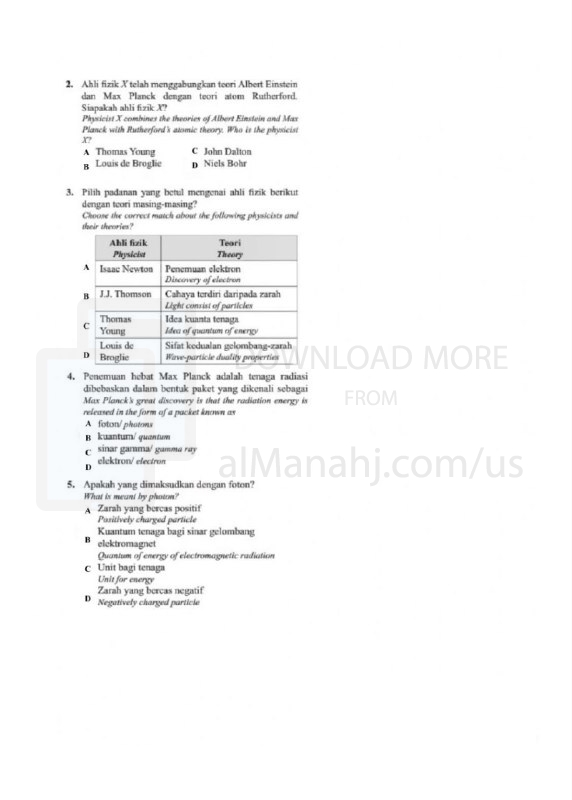| You are here: Almanahj Website ⇒ American curriculum ⇒ 11th Grade ⇒ Chemistry ⇒ Term 1 | ||
|---|---|---|
Worksheet about Quantum Physics | ||
|---|---|---|
| Subject: Chemistry | ||
| 11th Grade | ||
| Term 1 | ||
| Year: 2023/2024 | ||
| Size: 324.3KB | ||
| Number of clicks: 86 | ||
| Publish date:November 06, 2023 | ||
| Added by: Eman | ||
| Last download date: 2024-08-27 23:09:45 | ||
| Updated by: Eman9966 on 2023-11-06 06:34:17 | By: theodor Najwa Huda Shaharil | |
| File info: Quantum physics, also known as quantum mechanics, is a branch of physics that deals with the behavior of matter and energy at the smallest scales. It provides a framework for understanding the fundamental nature of particles and their interactions based on principles that are different from classical physics. At its core, quantum physics is based on the concept of quantization, which states that certain physical quantities, such as energy and angular momentum, can only exist in discrete, quantized values rather than continuous ones. This is in contrast to classical physics, where quantities can vary continuously. Key principles and concepts in quantum physics include:1. Wave-Particle Duality: Quantum physics recognizes that particles, such as electrons and photons, can exhibit both wave-like and particle-like properties. This means that they can behave as both waves and particles depending on the context of the experiment. 2. Superposition: According to quantum mechanics, particles can exist in multiple states simultaneously. This is known as superposition. For example, an electron can be in a superposition of being in multiple positions or having multiple energy states until it is measured or observed. 3. Uncertainty Principle: The uncertainty principle, formulated by Werner Heisenberg, states that it is impossible to simultaneously determine certain pairs of physical properties, such as position and momentum, with absolute precision. There is an inherent limit to the accuracy with which these properties can be known. 4. Quantum Entanglement: Quantum entanglement refers to a phenomenon in which two or more particles become correlated in such a way that the state of one particle cannot be described independently of the others, even when they are physically separated. Changes to one entangled particle will instantaneously affect the others, regardless of the distance between them. 5. Quantum States and Wavefunctions: Quantum states are described by mathematical entities called wavefunctions, which provide information about the probabilities of various outcomes when a measurement is made. The wavefunction evolves over time according to the Schrödinger equation, which is a fundamental equation in quantum mechanics. Quantum physics has far-reaching implications and finds applications in various fields, including particle physics, condensed matter physics, quantum computing, and quantum cryptography. It has revolutionized our understanding of the microscopic world and has led to the development of technologies that rely on quantum phenomena. | ||
| Downloading link Worksheet about Quantum Physics |
|---|
|
1699252395.pdf
The file is being prepared for download
|
| File images |
|---|
 |